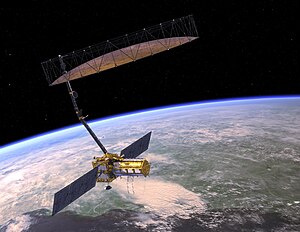NISAR (satellite)
 Artist's concept of the NASA-ISRO Synthetic Aperture Radar (NISAR) satellite. | |
| Names | NASA-ISRO Synthetic Aperture Radar NISAR |
|---|---|
| Mission type | Radar imaging |
| Operator | NASA / ISRO |
| Website | nisar www |
| Mission duration | 3 years (planned)[1][2] |
| Spacecraft properties | |
| Spacecraft | NISAR |
| Bus | I-3K[3] |
| Manufacturer | NASA / ISRO |
| Launch mass | 2,800 kg (6,200 lb)[4] |
| Power | 6,500 watts |
| Start of mission | |
| Launch date | Q1 2025 (planned)[5] |
| Rocket | GSLV Mk II (4 meter fairing)[3] |
| Launch site | Satish Dhawan Space Centre |
| Contractor | ISRO |
| Orbital parameters | |
| Reference system | Geocentric orbit[1] |
| Regime | Sun-synchronous orbit[6] |
| Altitude | 747 km (464 mi) |
| Perigee altitude | 747 km (464 mi) |
| Apogee altitude | 747 km (464 mi) |
| Inclination | 98.5° |
| Transponders | |
| Band | S-band L-band |
| Instruments | |
| L-band (24-cm wavelength) Polarimetric Synthetic Aperture Radar S-band (12-cm wavelength) Polarimetric Synthetic Aperture Radar | |
 NISAR mission logo | |
The NASA-ISRO Synthetic Aperture Radar (NISAR) mission is a joint project between NASA and ISRO to co-develop and launch a dual-frequency synthetic aperture radar on an Earth observation satellite in 2025. The satellite will be the first radar imaging satellite to use dual frequencies. It will be used for remote sensing, to observe and understand natural processes on Earth. For example, its left-facing instruments will study the Antarctic cryosphere.[7] With a total cost estimated at US$1.5 billion, NISAR is likely to be the world's most expensive Earth-imaging satellite.[8]
Overview
[edit]The NASA-ISRO Synthetic Aperture Radar, or NISAR satellite, will use advanced radar imaging to map the elevation of Earth's land and ice masses four to six times a month at resolutions of 5 to 10 meters.[9] It is designed to observe and measure some of the planet's most complex natural processes, including ecosystem disturbances, ice-sheet collapse, and natural hazards such as earthquakes, tsunamis, volcanoes and landslides.[10][11]
The mission is a partnership between NASA and ISRO.[10] Under the terms of the agreement, NASA will provide the mission's L-band synthetic aperture radar (SAR), a high-rate telecommunication subsystem for scientific data GPS receivers, a solid-state recorder, and a payload data subsystem. ISRO will provide the satellite bus, an S-band synthetic aperture radar (SAR), the launch vehicle, and associated launch services.[12]
All data from NISAR will be freely available one to two days after observation and within hours in case of emergencies like natural disasters.[9] Data collected from NISAR will reveal information about the evolution and state of Earth's crust, help scientists better understand our planet's natural processes and changing climate, and aid future resource and hazard management.[10]
The satellite will be three-axis stabilized. It will use a 12 m (39 ft) deployable mesh antenna and will operate on both the L- and S- microwave bands.[10] The aperture mesh reflector (antenna) will be supplied by Astro Aerospace, a Northrop Grumman company.[13]
ISRO's share of the project cost is about ₹788 crore (US$94 million), and NASA's share is about US$808 million.[14][15]
Launch
[edit]The satellite was originally scheduled to be launched from India aboard a GSLV Mark II on 30 March 2024, but it was postponed until further notice due to a needed hardware update.[16] The orbit will be a sun-synchronous, dawn-to-dusk type. The planned mission life is three years.[1] The satellite was fully integrated in January 2024 and was performing its final testing and analysis in preparation for launch.[17] However, in an interview with the Times of India, Chairman of ISRO S. Somanath said that though the GSLV for NISAR will be built by March-April, the satellite is still undergoing tests and they were expecting some delay.[18] Tests found that the reflector might face higher-than-expected temperatures when stowed during flight and so it was returned to the manufacturer in California to apply a reflective coating to mitigate the risk of overheating.[19][20]
On October 15 2024, after the completion of all checks and tests, NASA's C-130 took off from Wallops Flight Facility in Virginia, Tuesday, Oct. 15, to embark on the multi-leg, multi-day journey to India.The flight will first stop at March Air Reserve Base to retrieve the spacecraft followed by strategic stops at Hickman Air Force Base, Hawaii; Andersen Air Force Base, Guam; Clark Air Base, Philippines; and HAL Airport in Bengaluru, India.[21][22]
As of July 2024, NISAR is expected to be launched in early 2025.[5]
Gallery
[edit]-
NISAR diagram
-
NISAR undergoing tests
-
NISAR solar array
-
NISAR's DGA antenna
Payload
[edit]- L-band (1.25 GHz; 24 cm wavelength[3]) polarimetric SAR, to be produced by NASA.
- S-band (3.20 GHz; 9.3 cm wavelength[3]) polarimetric SAR, to be produced by ISRO.[17]
See also
[edit]- Earth observation satellite
- Indian Remote Sensing
- List of Indian satellites
- Seasat
- Shuttle Radar Topography Mission
References
[edit]- ^ a b c "Satellite: NISAR". World Meteorological Organization (WMO). 4 January 2020. Retrieved 16 March 2021.
- ^ "Optimization of Debris Shields on the NISAR Mission's L-Band Radar Instrument" (PDF). conference.sdo.esoc.esa.int. ESA Space Debris Office. 18–21 April 2017. Retrieved 16 March 2021.
- ^ a b c d "Overview of NISAR Mission and Airborne L- and S- SAR" (PDF). sac.gov.in. Space Applications Centre, ISRO. August 2018. Retrieved 16 March 2021.
- ^ Neeck, Steven. "The NASA Earth Science Program and Small Satellites" (PDF). dlr.de. DLR. Archived from the original (PDF) on 23 November 2018. Retrieved 23 November 2018.
- ^ a b "Amendment 33: A.27 NISAR Research and Applications Science Team Deferred to ROSES-25". Science Mission Directorate. 18 July 2024. Retrieved 28 July 2024.
- ^ "NISAR Mission". ISRO. 19–20 November 2015. Archived from the original on 4 August 2020. Retrieved 16 March 2021.
- ^ Witze, Alexandra (4 February 2019). "Arctic scientists iced out by U.S.–India radar mission". Nature. 566 (7742): 18. Bibcode:2019Natur.566...18W. doi:10.1038/d41586-019-00278-8. PMID 30723349.
- ^ "NASA, ISRO jointly working on project NISAR". NASA/JPL (Press release). SAR Journal. 26 May 2017. Retrieved 16 March 2021.
- ^ a b "Landslide Hazards to Infrastructure" (PDF). nisar.jpl.nasa.gov. NASA (JPL). 2017. Archived from the original (PDF) on 21 March 2019. Retrieved 16 March 2021.
 This article incorporates text from this source, which is in the public domain.
This article incorporates text from this source, which is in the public domain.
- ^ a b c d "NASA-ISRO SAR Mission (NISAR)". Jet Propulsion Laboratory. Retrieved 16 March 2021.
 This article incorporates text from this source, which is in the public domain.
This article incorporates text from this source, which is in the public domain.
- ^ "NASA-ISRO SAR (NISAR) Mission Science Users' Handbook" (PDF). NASA. Retrieved 27 May 2021.
 This article incorporates text from this source, which is in the public domain.
This article incorporates text from this source, which is in the public domain.
- ^ "U.S., India to Collaborate on Mars Exploration, Earth-Observing Mission". NASA. 30 September 2014. Retrieved 16 March 2021.
 This article incorporates text from this source, which is in the public domain.
This article incorporates text from this source, which is in the public domain.
- ^ White, AnnaMaria (30 October 2015). "NASA Jet Propulsion Laboratory Selects Northrop Grumman's Astro Aerospace for NISAR Reflector" (Press release). Northrop Grumman Corporation. GlobeNewswire. Retrieved 16 March 2021.
- ^ "Rajya Sabha Q. No.2223, Session:243 "JOINT PROJECT BETWEEN NASA AND ISRO"" (PDF). Department of Space. 3 August 2017. Archived from the original (PDF) on 3 August 2017. Retrieved 16 March 2021.
- ^ "Joint Project between NASA and ISRO". Press Information Bureau, Government of India. 3 August 2017. Retrieved 16 March 2021.
- ^ Foust, Jeff (24 March 2024). "Antenna work delays NISAR launch". SpaceNews. Retrieved 2 April 2024.
- ^ a b "ISRO's instrument design passes Nasa review". The Times of India. 31 July 2014. Retrieved 16 March 2021.
- ^ "Nisar only in 2nd half of 2024; Trishna gets nod". The Times of India. 19 March 2024. ISSN 0971-8257. Retrieved 23 March 2024.
- ^ "Isro's Nisar mission launch delayed, key component sent back to NASA". India Today. Retrieved 23 March 2024.
- ^ "Work Continues on NISAR Satellite as Mission Looks Toward Launch – NASA-ISRO SAR Mission (NISAR)". blogs.nasa.gov. 22 March 2024. Retrieved 23 March 2024.
- ^ "NASA's C-130 Aircraft En Route to India in Support of NISAR Mission - NASA". Retrieved 19 October 2024.
- ^ Pillai, Soumya; ThePrint (18 October 2024). "US C-130 en route to India with critical payload: NISAR's radar antenna reflector". ThePrint. Retrieved 19 October 2024.






